An Everyday DNA blog article
Written by: Sarah Sharman, PhD
Illustrated by: Cathleen Shaw
Correctly identifying things is of the utmost importance to us as humans. You certainly want to know someone’s identity before opening your door to an unexpected knock. In the food industry, it can mean the difference between life and death, like when foraging berries or mushrooms or avoiding allergens in your meals. Being unable to identify something or someone can cause frustration, like in the criminal justice system.
At the biological level, the most unique identifier for most organisms is their genotype or genetic makeup. Most living things are made up of DNA. The unique sequence of an organism’s DNA acts as a biological fingerprint. Let’s learn more about how scientists determine an organism’s genotype and how genotyping helps us identify things across many fields.
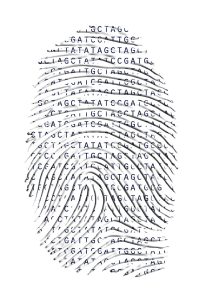
What is genotyping?
Over the past decade, genome sequencing emerged as a powerful tool to decipher the genetic code. Scientists can determine who or what a sample came from by sequencing and analyzing the DNA within a biological sample.
In many applications, scientists do not need to look at the entire genetic code to identify an individual from their DNA. They can look at specific sections of the genome known to be unique among groups of individuals, a process called genotyping.
For example, humans are 99.9 percent genetically identical to each other. While the one percent difference might seem small, it is what makes us unique from each other. Many differences include a single base change called a single nucleotide polymorphism (SNP). Genotyping tests can look at specific SNPs known to be responsible for certain traits or diseases.
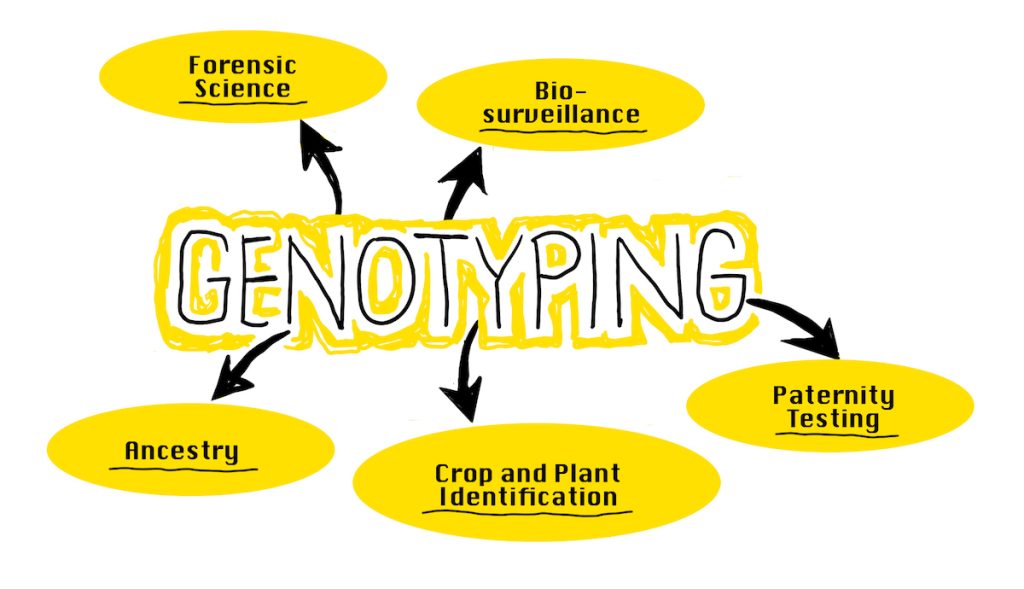 Applications of Genotyping: Forensic Science
Applications of Genotyping: Forensic Science
DNA technology is a powerful tool in forensic science. It can help law enforcement identify or eliminate individuals as perpetrators or victims of a crime when biological evidence like saliva, blood, or hair is left at a crime scene. DNA profiling helps exonerate wrongfully convicted individuals. It can also match missing persons to unidentified human remains and confirm paternity.
The use of DNA in forensics began in 1985 when British geneticist Sir Alec Jeffreys discovered that some areas of the human genome contain highly variable, repeating short DNA sequences. Two unrelated individuals are unlikely to have the same number of repeats in the same area of the genome. In the US, law enforcement agencies look at 20 genome regions to create a DNA fingerprint.
Crime labs extract DNA from biological samples from crime scenes to create a DNA profile. The profile from the crime scene sample is compared to DNA profiles from potential suspects. If the two profiles match across a set of 20 standard DNA markers, forensic specialists conclude that the suspect is the source of the crime scene evidence. Investigators can use the DNA match to investigate further to determine if the suspect is the perpetrator.
DNA fingerprinting has helped solve thousands of crimes since its inception. To learn more about DNA fingerprinting and other applications of DNA technology in forensic science, listen to Tiny Expeditions Season 4, Episode 1, “The Science of Crime: Forensics and DNA Technology.”
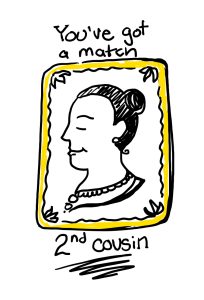 Applications of Genotyping: Ancestry
Applications of Genotyping: Ancestry
Children inherit half of their DNA from their mother and half from their father. Their parents inherited half of their DNA from their mother, half from their father, and so on. Because DNA is inherited in a predictable fashion, analyzing an individual’s DNA can give clues about their ancestry.
By now, anyone with a television or the internet probably knows about the many genetic testing companies that promise to use your DNA to connect you with unknown relatives. These types of ancestry tests don’t look at your entire genome; they just look at specific markers in your DNA associated with different populations worldwide.
Scientists compare your DNA with large databases of samples from various regions to estimate your genetic ancestry. The results might show a percentage breakdown of your ancestry, indicating that you have a certain percentage from Europe, Africa, Asia, etc.
These databases also have an option where people can receive genetic matches with others in the database who’ve also opted in. Listen to Tiny Expeditions, Season 3, Episode 1, “The Story of Humanity Written in Your DNA,” to learn more about ancestry and DNA and how a HudsonAlpha faculty investigator found an unknown family member.
Applications of Genotyping: Biosurveillance
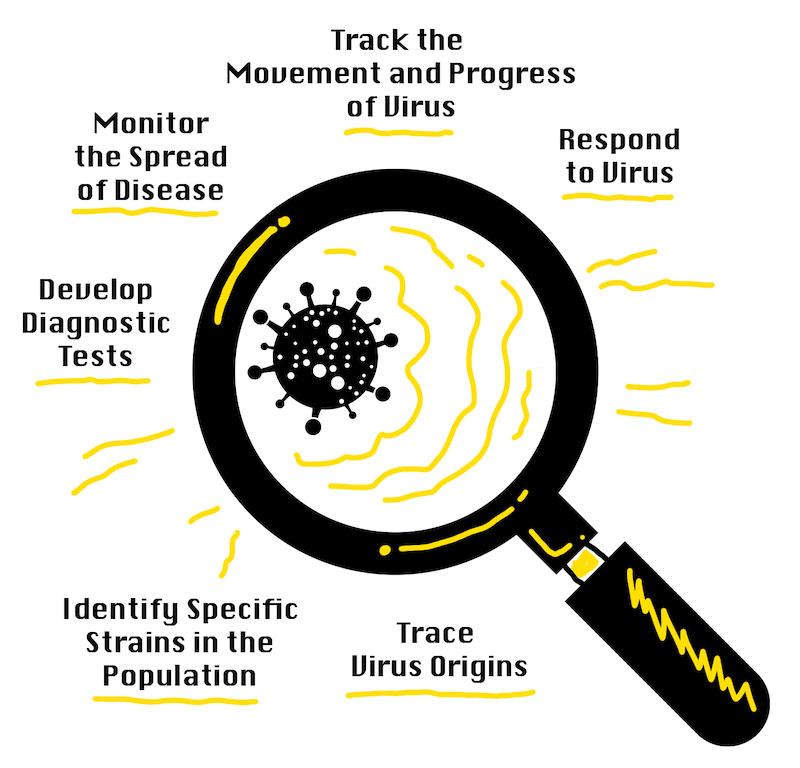
It is winter, coming off of the holiday season. Everyone was busy visiting with family, attending holiday parties, and spending time indoors during the cold snap. Flu, coronaviruses, and other respiratory viruses were not on holiday. As we all flock to our doctor’s offices in search of relief, we can thank genetic technology and genotyping for rapid tests and some of the treatments we’ll be given.
Very early in the SARS-CoV-2 outbreak, scientists worldwide began sequencing the virus to find out exactly what it was and how they could combat it. This quick action allowed other scientists and drug companies to start working on vaccines and treatments specific to the virus.
By understanding the genetic makeup of viruses, scientists can also create genotyping tests that look at unique parts of each virus’s genetic code. This allows them to develop diagnostic tests, monitor and respond to the spread of disease, trace the origin and movement of the disease, and identify specific strains circulating in a population. All of this allows for quicker identification of the source of an outbreak and its transmission patterns, which is vital for implementing timely interventions.
To learn more about viral surveillance, listen to Tiny Expeditions, Season 4, Episode 4, “The future of pandemic preparedness: Insights from biotech experts.”
Applications of Genotyping: Crop and Plant Identification
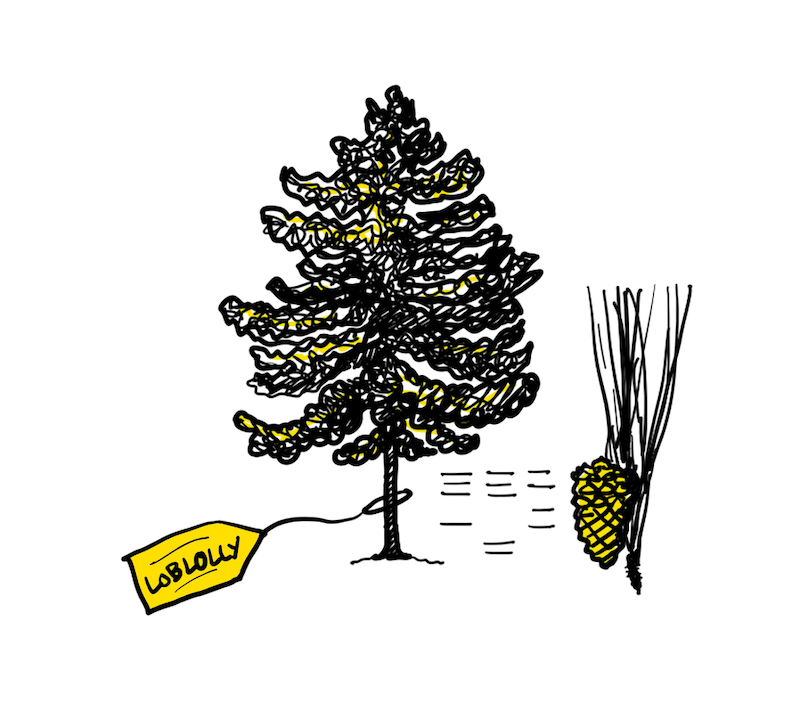 Food and shelter are two fundamental human needs. Without them, we cannot survive. Plants are critical components of our food and the shelters that keep us safe. Amidst our ever-changing environment, some plant species are struggling to survive. Scientists and plant breeders rely on genetics to create crop and plant varieties better equipped to thrive in specific conditions.
Food and shelter are two fundamental human needs. Without them, we cannot survive. Plants are critical components of our food and the shelters that keep us safe. Amidst our ever-changing environment, some plant species are struggling to survive. Scientists and plant breeders rely on genetics to create crop and plant varieties better equipped to thrive in specific conditions.
Plant breeders and farmers need an accurate way to verify they are planting and breeding the intended type of plant in their fields, orchards, and tree stands. Through genotyping, they can identify specific genetic markers unique to each plant variety. Breeders collect DNA from plant tissue and analyze it for a set of specific short DNA markers indicative of their intended plant variety.
For many plants, traits of interest are not visible until late in the plant’s development. Genotyping plants early in their life allows growers to remove unwanted plants to save time and money on watering, fertilizing, and caring for the wrong type of plant.
The timber industry is an extreme example, with trees taking up to 25 years to reach maturity before growers know the quality of the tree. If the trees are not up to the buyer’s standards, the grower loses 25 years of time and resources. Scientists at HudsonAlpha hope to save Alabama timber growers time and money by incorporating genetic technology into their industry.
The TIMBER project (Turning Information into Meaningful Benefits and Economic Returns), led by Faculty Investigator Josh Clevenger, PhD, will use a sequencing and analysis tool called Khufu to determine the exact tree specifications much earlier in their lifetime at the seedling stage. Khufu, developed by Clevenger and Walid Khorani, PhD, will use rapid genotyping to accurately identify and type trees in a tree stand. The project will test two important pine species for Alabama tree farmers and the lumber industry.



